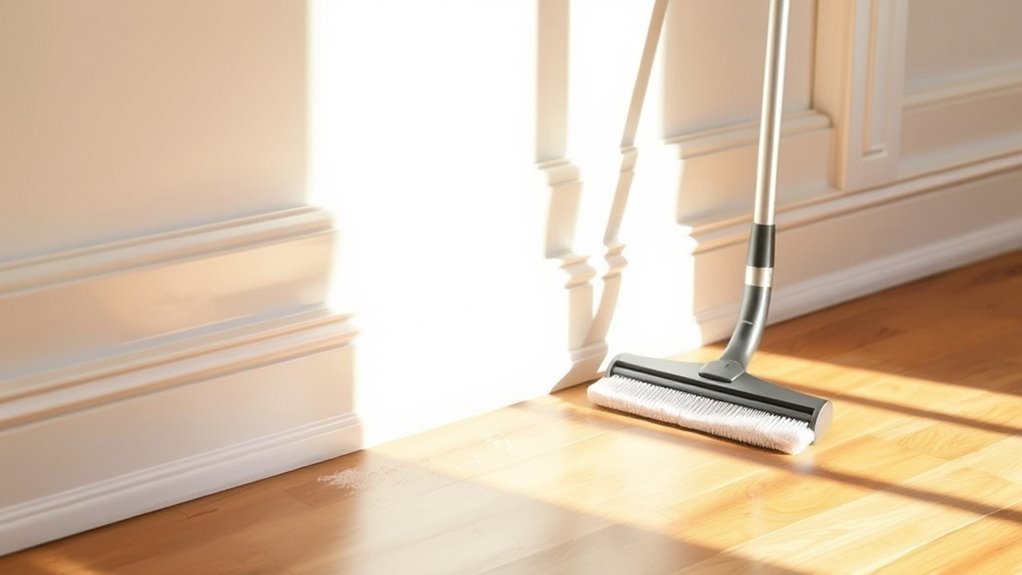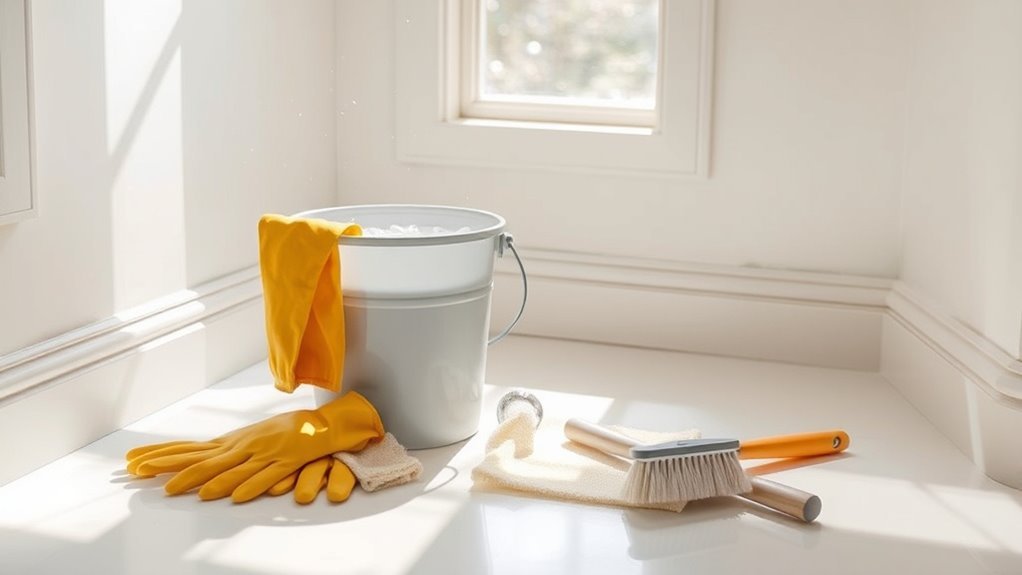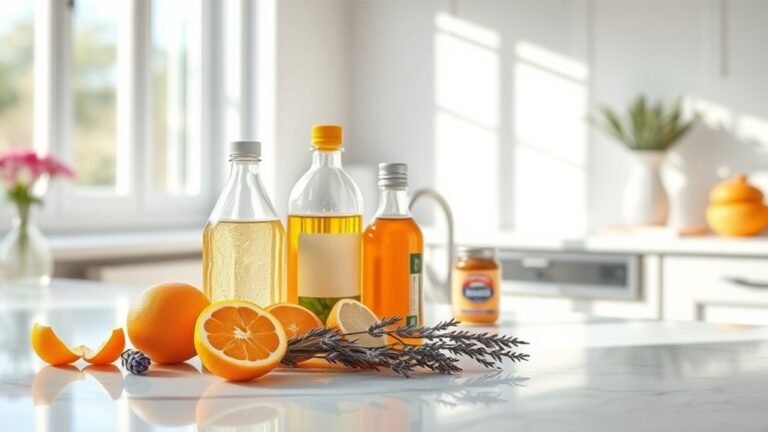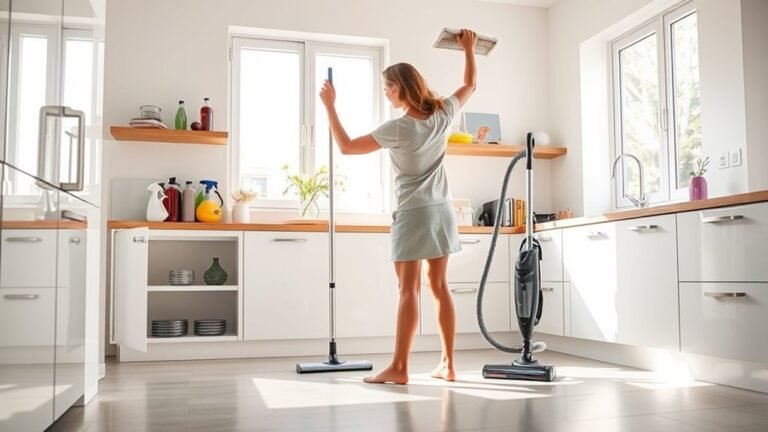Spring Cleaning Guide for Baseboards
You’ll want to start your spring cleaning by dusting your baseboards with a microfiber cloth or vacuum brush to remove dirt and allergens. Next, use a gentle cleaner or homemade mix of vinegar and water to tackle grime. For tough stains, try a magic eraser or baking soda paste. Don’t forget preventative tips like furniture pads to keep them clean longer. Keep going to discover the best tools and eco-friendly tricks for a fresh, inviting home.
Why Baseboards Need Regular Cleaning

Although baseboards might seem like a small detail, they collect dust, dirt, and grime just like any other surface in your home. Ignoring baseboard maintenance can make your space look neglected and limit your freedom to enjoy a truly clean environment. Regular cleaning keeps allergens at bay and preserves the paint or finish, preventing costly repairs later on. You don’t have to clean them daily, but setting a cleaning frequency—like once a month or during seasonal deep cleans—helps maintain their appearance and your home’s overall freshness. Staying on top of this simple task gives you control over your living space, so you can relax in a home that feels open, inviting, and well cared for without unnecessary hassle.
Essential Tools and Cleaning Supplies
To get your baseboards looking fresh, you’ll need the right tools and cleaning solutions. Simple items like microfiber cloths, a soft brush, and a gentle cleaner can make a big difference. Let’s explore which supplies work best to tackle dust and grime effectively.
Must-Have Cleaning Tools
Several essential tools and cleaning supplies will make tackling your baseboards much easier and more effective. Depending on your baseboard materials—whether wood, vinyl, or painted surfaces—you’ll want tools that won’t damage them during cleaning. A soft microfiber cloth is perfect for gentle dusting, while a small, angled brush helps reach grooves and corners where dirt hides. A vacuum with a brush attachment can speed up your routine, especially if you keep a regular cleaning frequency. For stubborn grime, a sponge with a non-abrasive side works wonders. Don’t forget gloves to protect your hands and a bucket for water or mild cleaning solutions. With these tools, you’re set to clean freely and efficiently, maintaining your baseboards’ appearance without hassle.
Effective Cleaning Solutions
When you want your baseboards to shine without damage, choosing the right cleaning solutions is key. Different baseboard materials—wood, vinyl, or painted surfaces—respond best to specific cleaners. For wood, opt for a mild soap diluted in warm water to preserve its finish. Vinyl or painted baseboards can handle gentle all-purpose cleaners or a vinegar-water mix. Keep your cleaning frequency in mind; regular gentle cleaning prevents buildup, reducing the need for harsh treatments. Avoid abrasive chemicals that could strip paint or damage wood. Also, have microfiber cloths and soft brushes handy—they work great with your chosen solutions to lift dirt without scratching. By matching your cleaning supplies to your baseboard materials and maintaining consistent cleaning frequency, you’ll enjoy fresh, flawless baseboards that add freedom and comfort to your living space.
Step-by-Step Baseboard Cleaning Process

First, you’ll want to remove all the dust using a vacuum or microfiber cloth to get a clean surface. Next, tackle any stubborn stains with a gentle cleaner or a homemade solution. Finally, finish up with some quick touch-ups to make your baseboards look fresh and spotless.
Dust Removal Techniques
Anyone tackling baseboard cleaning knows that dust buildup can be stubborn and tricky to remove. To keep your baseboards looking fresh, start by understanding your baseboard materials—wood, vinyl, or MDF all require gentle dusting tools like microfiber cloths or soft brushes. Regular cleaning frequency is key; dust them at least once a week to prevent thick layers. Begin by vacuuming with a brush attachment to loosen dirt, then wipe down with a damp microfiber cloth. For hard-to-reach grooves, use a cotton swab or a soft toothbrush. This simple routine not only preserves your baseboards’ appearance but also frees you from constant deep cleaning sessions. Staying consistent gives you more time to enjoy your space dust-free and hassle-free.
Stubborn Stain Solutions
Although regular dusting keeps your baseboards looking good, stubborn stains can still appear and spoil their finish. Don’t let these marks hold you back from enjoying a fresh, clean home. Here’s how to tackle stain removal with effective cleaning techniques:
- Mix a gentle detergent with warm water to avoid damaging the paint.
- Use a soft cloth or sponge to gently scrub the stained area.
- For tougher stains, try a paste of baking soda and water—apply, let sit, then wipe clean.
- Rinse with a damp cloth and dry thoroughly to prevent moisture damage.
These steps give you control over your environment, freeing you from the frustration of tough stains and keeping your baseboards pristine.
Final Touch-Up Tips
After handling stubborn stains, it’s time to give your baseboards a final once-over to confirm they look spotless. Start with a quick final inspection, checking for missed spots or lingering dust. Use a microfiber cloth or a soft brush to gently wipe away any remaining debris. This last step assures every inch shines, reflecting your effort and care. Once satisfied, think about setting up a maintenance schedule to keep your baseboards looking fresh year-round. Regular touch-ups prevent grime buildup and save you from heavy cleanings later. By sticking to a simple routine, you’ll enjoy the freedom of a consistently clean home without stress. Remember, a little upkeep goes a long way toward preserving your space’s crisp, polished vibe.
Removing Stubborn Stains and Scuff Marks

When you come across stubborn stains and scuff marks on your baseboards, simple cleaning methods might not be enough to remove them. Don’t let these blemishes hold you back—here’s how to reclaim that fresh look:
- Use a magic eraser gently on scuff marks; it’s great for lifting without damage.
- Apply a paste of baking soda and water for tough stain removal; let it sit briefly before wiping.
- Try a small amount of white vinegar on a cloth for persistent marks, but test first to avoid discoloration.
- For painted baseboards, consider touch-up paint after cleaning to restore flawless freedom from stains.
With these steps, you’ll break free from stubborn grime and reveal your baseboards’ true shine.
Preventative Tips to Keep Baseboards Clean Longer
To keep your baseboards looking fresh longer, you’ll want to adopt a few simple habits that prevent dirt and damage before they start. Preventative maintenance is key—regularly dust your baseboards with a microfiber cloth to stop buildup. Make it part of your cleaning routine so it doesn’t become a chore. Conduct routine inspections every couple of weeks to spot any scuffs, chips, or signs of wear early. Catching these small issues lets you address them quickly, avoiding bigger repairs later. Also, consider placing doorstops or furniture pads to protect baseboards from bumps and scratches. By staying proactive with cleaning and inspections, you’ll free yourself from constant deep cleanings and keep your space looking effortlessly polished. This approach lets you enjoy your home without feeling tied down by maintenance.
Eco-Friendly Cleaning Alternatives for Baseboards
Keeping your baseboards clean doesn’t have to mean using harsh chemicals that can harm the environment or your indoor air quality. You can enjoy freedom from toxins by choosing green alternatives made from natural ingredients. Here’s how to get started:
- Mix equal parts white vinegar and water for an effective, natural cleaner.
- Use baking soda as a gentle scrub to remove stubborn dirt without damaging surfaces.
- Add a few drops of essential oils like lemon or tea tree for freshness and extra cleaning power.
- Opt for reusable microfiber cloths instead of disposable wipes to reduce waste.
These eco-friendly options let you maintain spotless baseboards while protecting your health and the planet. Embrace these green alternatives and clean with confidence!
Frequently Asked Questions
Can Baseboards Be Painted During Spring Cleaning?
You can definitely tackle baseboard painting during spring cleaning—it’s a great way to freshen up your space. Since you’re already in cleaning mode, prepping your baseboards by wiping off dust and grime will make the paint stick better. You don’t have to follow strict rules; just pick a paint that suits your vibe and go for it. This freedom lets you transform your room effortlessly while enjoying the season’s fresh energy.
How Often Should Baseboards Be Replaced Instead of Cleaned?
You should consider baseboard replacement signs like deep cracks, warping, or persistent stains that cleaning can’t fix. If you’re cleaning your baseboards regularly—say, every few months—and they still look worn or damaged, it might be time for a change. Don’t feel stuck with old, tired baseboards; swapping them out can refresh your space and give you the freedom to create a cleaner, more polished look without endless scrubbing.
Are There Specific Cleaners for Wooden Versus Vinyl Baseboards?
Yes, you’ll want to use different cleaning solutions based on the material types of your baseboards. For wooden baseboards, opt for gentle, wood-safe cleaners or a mix of mild soap and water to avoid damage. Vinyl baseboards can handle stronger, all-purpose cleaners since they’re more durable. Choosing the right cleaner lets you keep your baseboards looking fresh without worrying about harming the material, giving you freedom to maintain your space confidently.
Can Pets Damage Baseboards and Affect Cleaning Methods?
Yes, pets can definitely damage baseboards with pet claw marks, which might require you to clean more often and gently. You’ll want to increase cleaning frequency to keep those marks from building up and becoming harder to remove. Using non-toxic cleaners is smart since your furry friends roam around. Embrace a flexible cleaning routine that fits your lifestyle, so your baseboards stay fresh without feeling like a chore.
What Are the Best Ways to Protect Baseboards From Moisture?
To protect your baseboards from moisture, you’ll want to focus on moisture barriers and baseboard sealing. Installing moisture barriers behind baseboards can prevent dampness from seeping in, while applying a quality sealant on the surface keeps water out. Don’t forget to fix any leaks or spills quickly and guarantee good ventilation. These steps give your baseboards the freedom to stay dry and damage-free, so you can enjoy a worry-free space.






